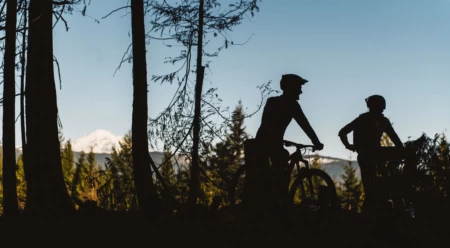What Good Neighbors Do
In the 1980s, a group of cyclists in Washington banded together to protect their local trails from illicit activities; 30 years later, that momentum has reshaped the city and preserved a watershed.
Eric “EB Extreme” Brown scurries up the root wad, surveying the devastation that once was Cougar Ridge Trail. Located on the east side of Lake Whatcom, east of Bellingham, Washington, “Cougar” was once an unsanctioned downhiller trail scheduled for closure. Now it’s one of the area’s premier—and legal—rides.
This section, however, is a mess of rocks, dirt and wooden tentacles, the aftermath of three enormous trees blown down in a recent storm. But EB isn’t daunted.
The former online product manager and his wife, Courtney, moved from Seattle in 2008. As the trail director for the county’s mountain-biking advocacy group, the Whatcom Mountain Bike Coalition (WMBC), he’s been a fixture at civic meetings, public forums, races and events, and—of course—on Bellingham’s trails. WMBC’s first paid, full-time employee talks as fast as he moves, crawling through the forest like a scruffy Tasmanian devil as he alternates between plans to reroute the trail, rebuild it or literally jack the stumps back into place. It’s why the unofficial “MTB Mayor of Bellingham” is so effective: He doesn’t battle challenges. He overwhelms them with a flood of optimistic ambition.
My phone rings, showing a California number: Jim “Sully” Sullivan. He tells me to high-five “Rico Suave,” his nickname for EB. I do, then I tell Sully how amazing it is that Cougar is no longer illegal. He immediately corrects me.
“I really suggest you don’t call them ‘illegal,’” he says. “Whenever hikers, horse folk or dog walkers go to a pretty place or connect two parallel trails, it’s considered a positive thing—a softball offense, at worse. When it’s bicycles, it’s illegal.”
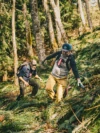
Eric Brown (front) and Reid Parker (rear) route a new climbing trail across the slopes of Stewart Mountain. Photo: Paris Gore
In places like Montana, California, Idaho and even Washington, bicyclists and environmentalists are often on different sides of conservation debates. But not in Bellingham. When it comes to (literal) hands-in-the-dirt activism, few are more involved than the mountain biking community. Led by the WMBC, they have helped pass green-fund levies and they show up to trail-work parties in the dozens, even when those trails will never see tire treads. WMBC’s blue and green tent is a fixture at events across Whatcom, emblazoned with their mission statement: “To preserve and enhance nonmotorized trail access in Whatcom County through stewardship, education and advocacy.”
And the whole story began with illegal trash dumping, an espresso machine and some good neighbors.
If EB is the mayor of two-wheeled Bellingham, Sully is its godfather—and their shared “office” would be Galbraith Mountain, the beating heart of Pacific Northwest mountain biking. And it’s a pretty damn ugly one.
Officially named Lookout Mountain, “Galby” does not include the huge, second-growth forest surrounding us, complete with ferns and multiple waterfalls. It does, however, include the clearcut we rode through to get here: The 1,785-foot prominence is a working forest, and has been regularly logged for decades. But it’s also home to 65 miles of world-class single track, where on any given day you can find dozens of mountain bikers, hikers, trail runners and even a few horse riders. Every other car in town seems to be loaded with bikes, and every road with bicyclists. Nearly all of them are headed to Galbraith.
“You can’t live in Whatcom County without running into somebody who spends time on Galbraith,” says Rich Bowers, director of the Whatcom Land Trust. “Bellingham has had mountain bikers involved and physically working on Galbraith for 30 years, and that helps build a reputation.”
Sully first visited Bellingham in 1974, on a bicycle tour between hot springs on the West Coast; in 1979, he bought a house at the base of Galbraith and started an espresso machine repair business. Though he didn’t mountain bike—the sport had only been “invented” two years before—few people were more familiar with “fat-tire bikes.” He’d grown up next door to the legendary Tom Ritchey, one of the first mountain bikers, in the shadow of California’s Mount Tamalpais, arguably its birthplace.
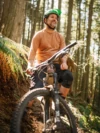
Eric Brown, the unofficial Mayor of Bellingham Mountain Biking. Photo: Paris Gore
Tucked to the east of the San Juan Islands, about 80 miles north of Seattle and 60 miles south of Vancouver, British Columbia, “The City of Subdued Excitement” is home to nearly 90,000 people. It’s also home to three national mountain-bike companies and four custom-bike builders, a bicycle car-rack company, a trail-building tool company, a seat-post company and Freehub MTB Magazine. It has as many bike shops as breweries (13, as of early 2019).
The two-wheeled trend extends across Whatcom County, a largely rural chunk of land stretching east from Bellingham and over the crest of the Cascade Mountains. According to a 2015 analysis by Recreation Northwest, outdoor recreation generates an annual $705 million in revenue for the county and 3,728 jobs.
Unsurprisingly, Bellingham is also a conservation town. Perhaps the most telling proof of that is outdoor recreation’s impact on the region’s landscape: Recreation Northwest estimates it contributes from $6 billion to $10 billion a year in ecosystem services.
Sully started riding in the early ’80s, and his house soon became Bellingham’s mountain-bike gathering spot. On Tuesday nights, a handful of “crackpot psycho ceramics” would meet for a shot of espresso and “range” along the trails and old 4×4 roads in the hills surrounding town.
“You should have seen Galbraith,” he says. “It was gouged up by four-wheelers and dirt bikes, access gates were yanked down, and people regularly dumped garbage around the mountain. That’s why it’s important to put ‘mountain’ in front of ‘bikers.’ That clarifies right away we’re nonmotorized.”
For Sully, that wording held a special importance. In California, he had witnessed the vehement resistance the first mountain bikers faced as they were banned from nearly all the trails.
“Everything that starts in California inevitably works its way to the rest of the nation,” he says. “I wanted to establish us as courteous members of the outdoor community. Anyone can show up once, but we were dependable. We were good neighbors, and they saw us as a young, energetic group who showed up and did stuff.”
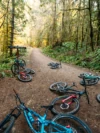
The best kind of traffic jam. A posse of bikes marks the top of Double Down while the owners survey a section of rocks and roots at the start of the trail. Photo: Paris Gore
To avoid resistance in Bellingham, Sully made friends. He talked with dog walkers, hikers, birdwatchers, neighborhood associations, even the Backcountry Horsemen of Washington, making sure his group’s work made sense for everyone. Galbraith-area residents began calling him to report illegal activities, and as the Tuesday night rides expanded, some reputable characters appeared among their “gaggle of nutjobs.”
“When you bring in the good guys, the bad guys go away,” Sully says. “We had police officers, doctors, firefighters and people in the public prosecutor’s office. We’d pass along a license plate number or a dumper’s description, and they’d have to go clean up their mess. Let me tell you, those sorts of activities stopped.”
Mountain bikers had become Galbraith’s unofficial guard force, and people noticed—including the logging company that owned most of Galbraith and gave the new user group a warm welcome. With a 3,000-acre backyard to roam, Sully began organizing Saturday rides as well; in a few months, they were drawing 60-plus people each week.
To harness this momentum, in 1987 Sully and a core group of riders “coalesced” into Bellingham’s first official mountain bike advocacy group. The Whatcom Independent Mountain Pedalers and Yo-Yos, or WHIMPYS (shortened to “WHIMPS” in the early ’90s), could put on races, manage large projects, lobby for positive development, and have a voice in local conservation policies. The first Greenway levy was one of them; first passed in 1990, the property tax funded habitat preservation, parks, trails and open spaces. Sully was a founding board member.
In 1996, Sully returned to California to recover from a second open-heart surgery. He passed the reins to then-vice-president Mark Peterson, who oversaw what was both a glory era and one of internal conflict. In the early 2000s, freeride mountain biking was on the rise, a style of riding that incorporated jumps, drops and precarious wooden stunts, often dangerous to ride, highly impactful to construct and usually done in secret. Freeriding’s rebellious, moto-esque mindset fueled the conflict between conservationists and mountain bikers, and in Bellingham it immediately generated tension with other user groups and the cross-country-leaning WHIMPS.
“The early generation, guys like Jim Sullivan and Mark Peterson, had a real conservation ethic,” says Mitch Friedman, founder and executive director of Conservation Northwest. “These freeriders, who were into the gear, the speed, the adrenaline rush, would cut down trees to build ramps and things like that. I was trying to persuade WHIMPS’s leadership that this was bad for their movement, that being better citizens would be better in the long term—let’s work together and set a higher standard.”
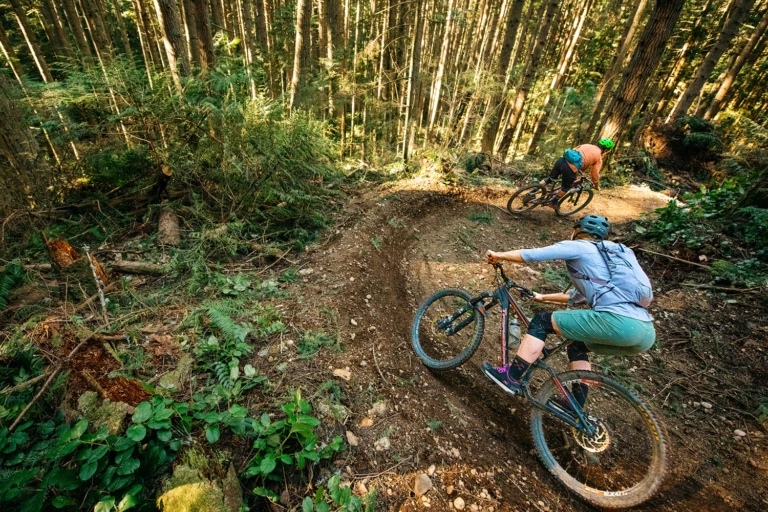
Bonnie Burke (front) and Eric Brown (rear) play follow the leader on their way down Cougar Ridge, a formerly unsanctioned, downhill-oriented trail linking Galbraith to the reconveyance’s southern side. Photo: Paris Gore
This became a significant issue in 2002, after the group organized a landmark access agreement with Trillium Corporation that made the WHIMPS official stewards of Galbraith. Peterson and vice-president Darren Clark knew if they could legitimize and point the freeriders in the right direction, that standard could be stratospheric. Bill Hawk and Matt Durand offered a reputable bridge between the factions: Both freeriders, they were also both local teachers. The two joined the WHIMPS board of directors in 2004—where they helped tear down all the wooden stunts on Galbraith, some of which they’d helped build.
“That was rough,” Peterson says. “There were a lot of hard feelings. But I really think it was a key moment in the club’s history, that tearing down everything was what allowed us to rebuild into what we are today. It proved we were legitimate, that we knew how to compromise to reach long-term goals.”
It paid off. The freshly dubbed WHIMPS Mountain Bike Coalition earned their nonprofit status in 2005, and over the next decade miles of new multiuser trails wormed their way across the mountain. But all of this was in limbo on April 18, 2011, as a crowd filed into Bellingham High School’s gymnasium.
Two years before, Trillium had deeded their 3,000 acres on Galbraith to developer Polygon Financial, in lieu of an $18 million debt. Then on April 11, 2011, Polygon announced they were closing Galbraith to the public. In response, Peterson invited Blair Murray, Polygon’s land manager, to a public forum at the school.
“The mayor was there, the city and county council members were there,” says EB, who’d been involved in the premeeting negotiations. “And 500 mountain bikers showed up with a few days’ notice on a weeknight. It was crazy.”
Shortly after, the company agreed to keep Galbraith open.
The hillside is steep. Really steep. If it were any less so, the thick salmonberry and devil’s club would be a thorny nightmare, but on the flanks of Stewart Mountain they serve as a veggie belay, allowing us to swing across the slope with a modicum of safety. Below us, the slope of gray-green columns of fir and hemlock plunges for 2,000 vertical feet into the dark waters of Lake Whatcom.
EB and Reid Parker think it’s the perfect place for a mountain bike trail.

Teach ’em young. Wielding her own purple-painted hoe and rubber boots, Cloe Brown helps her dad during a trail day on Galbraith. The bimonthly work parties regularly draw dozens of volunteers, including families and riders of all ages. Photo: Paris Gore
The two weave between Douglas firs in search of a friendlier way forward, pausing every 100 feet to tie pink flagging around a branch and mark a GPS waypoint. Parker is the conservation and parks steward for Whatcom County, and the duo will repeat this hike at least twice before county planners review the route for environmental impacts and potential for landslides. Then they’ll return with shovels, five-gallon buckets, volunteers and a few backpacks of beer.
The first clearing is a mess of rotting slash, remnants of the area’s most recent clearcut—and, as of 2014, the last. In the early ’90s, a series of landslides ripped off these same slopes, the result of a century of logging. The slides threatened residents and polluted the lake, and with Conservation Northwest’s support, more than 5,000 citizens successfully petitioned the state legislator to direct the landowner, the Department of Natural Resources, to come up with a management plan to protect the Lake Whatcom watershed.
Founded in 1957, the DNR manages 5.6 million acres across Washington, under a trust mandate that requires them to use the land to generate revenue for public schools, state institutions and county services. The counties can only take back these trust lands to create parks, so Conservation Northwest led a coalition with just that purpose. After a decade of tumultuous negotiations, in 2005 Whatcom County began planning a huge preserve spanning both sides of Lake Whatcom.
The decision fanned tensions within WMBC: Some members opposed the reconveyance, and Peterson, EB, Hawk, Durand (who took over as WMBC president in 2013) and other prominent advocates urged their peers to reconsider. The turning point came in 2012, when the DNR closed a trail network east of Bellingham, undermining the agency’s formerly recreation-friendly reputation. Faced with an opportunity almost four times larger than Galbraith, the mountain bike community quickly became the loudest pro-conservation voice in the room.
“Mark was very supportive, and there were times he was frustrated with WMBC,” Friedman says. “And there were tense times with Eric and others, because they needed to represent the whole of WMBC, including those with a different ethic. But they were invaluable; we couldn’t have done it without them. Eric was a core part of that, and we could count on him to turn out mountain bikers in great numbers at public hearings. They were good citizens.”
In March 2013, the Whatcom County Council voted to set aside 8,840 acres of former timberland for conservation and nonmotorized recreation. The 4,593 acres encompassing Stewart and the 4,251 acres on Lookout officially became part of Lake Whatcom Park: the seventh-largest locally managed park in the nation, protecting a quarter of the total Lake Whatcom watershed, the source of Bellingham’s drinking water. The development plan includes 95 miles of new single track, largely open to mountain bikes.
This momentum continued into 2015 at Larrabee State Park, a 10-mile drive from Galbraith’s southern trailhead. Washington’s first state park is 2,683-acres of waist-deep sword fern, waterfalls, lakes and gloomy old growth straddling the sandstone spine of the Chuckanut Mountains. Starting at the Cyrus Gates Overlook and ending at the stony shores of Clayton Beach, the Double Down Trail twists its way down the entirety of the “Chuckies” fir-covered, 1,800-vertical-foot western slope. WMBC built the downhill-only, mountain-bike-specific trail in 2015 with the park’s approval—the fruit of a 20-plus-year partnership reaching back to Peterson’s involvement in the 1994 Chuckanut Master Development Plan.
The Chuckanuts were also the site of WMBC and Conservation Northwest’s most recent collaboration: Mount Blanchard, a short slide south along the range. After a decade of citizen activism, in 2018 the state legislator designated the 1,600-acre chunk of DNR-managed lands as the Harriet Spanel State Forest. It draws over 100,000 visitors a year, and will never be logged.
“Along with Galbraith, the Lake Whatcom Reconveyance and Mount Blanchard are two issues that really engaged mountain bikers and conservationists together,” Friedman says. “Those were both vital coalitions.”
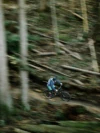
Cougar Ridge is a mix of roots, rocks and raw loam, so it’s important to let your brake fingers rest during the occasional smooth stretch. Bonnie Burke keeps it wide open on one of the trail’s high-speed sections. Photo: Paris Gore
It’s 60 degrees when we finally emerge, scratched and soaked, from Stewart’s forested slopes. EB and Parker are at the truck, discussing logistics over a topo map spread across the tailgate. In 2017, WMBC broke ground on the bottom half of the Chanterelle climbing trail, the first of the reconveyance’s 95 future miles. We’ve spent the morning mapping the second.
EB traces our path on the map, before diving into WMBC’s long list of ambitions. One is just north of Stewart, another 3,300-acre DNR parcel which WMBC hopes to tie into the reconveyance trail system. While it would remain trust land, it could channel new, recreation-based opportunities to nearby logging communities like Kendall and Deming that have struggled in recent years.
“As we reach these rural towns, we want to support the type of economy that both attracts tourism and provides an outlet for the kids and families that live in these areas,” he says. “That will be a big component to what we do in the future.”
But EB gets most excited about the mongrel forest across the ridge: Galbraith Mountain, Bellingham’s misfit mecca. The reason, however, is one I’ve never heard before: Since 2002, access to Galby has hinged on a month-to-month agreement, an uncertainty that prevented the local tourism industry from promoting the trail system and WMBC from securing public grants. The culture, economic growth and citizen activism that mountain biking has inspired over the past 30 years could, technically, have ended with 30 days’ notice.
“Here we are, building miles and miles of trail every year, spending all these volunteer resources, on the hopes and dreams it would eventually be guaranteed forever,” he says. “Some people said we were crazy, but it was all in good faith.”
That trust proved well-founded. In July 2018, the City of Bellingham, Whatcom Land Trust and Galbraith Tree Farm, LLC—who bought the land from Polygon in 2017—entered into an agreement securing public access to Galbraith and its 50-plus miles of trail “in perpetuity.” Using funds from the same Greenways Program Sully helped create, the coalition purchased permanent recreation and conservation easements from the logging company, with the city contributing $2.75 million and the Whatcom Land Trust $250,000. WMBC took responsibility for a new, much-needed $300,000 parking lot, as well as all trail maintenance.
The deal wasn’t perfect; the land remains a working forest. But the conservation easement permanently prohibits any development on the mountain, which encompasses 1,000 acres of the Whatcom watershed and connects green spaces like the reconveyance and the Chuckanuts. And it always will, regardless of changing politics or ownership.
“Buying the easements is a permanent solution that’s not just based on legislation,” says Bowers. “We always thought national parks were sacrosanct, but now that’s unclear. In 100 years, Galbraith will still be a mountain biking area, but also a place for hikers, runners, dog walkers or just families walking in the woods.”
Sully, however, was never worried about Galbraith’s fate, especially after his visit to Bellingham in October 2018, where he and Peterson were presented with WMBC’s Lifetime Achievement Awards in front of 700 mountain bikers. Trust is just what good neighbors do.
“You can accomplish things standing alone, but like any endeavor, to be really effective you have to join hands and work together,” he says. “That’s what established us as the good guys.”
